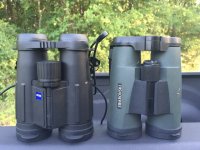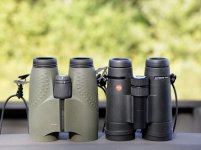Used the 6,5x32 format for quite a while, along with 10x32. Found that my newly-acquired 8x30 E II was just as good at delivering detail as was my 10x32 FL, which marked a sharp departure from the two-binoculars route when I abandoned the 10x format.
The E II was soon followed by a Meopta 8x32. I looked for any good 7x42 for a long time since I wanted a really serious birding instrument, and finally I went with an EDG II 7x42. I figured it would be as quick in use as the 6,5x32, but it wasn't. What I have with it is the huge exit pupil and outstanding image quality, but I tend to think of it as a 8x42 with a 6 mm exit pupil, if you understand the idea. My Meostar 8x32 is my main choice for warblering despite its higher magnification. True FOV is the same, but the Meostar is quicker to raise to the eyes and focus.
Today, I would probably have chosen the EDG II 8x42 instead, or the Monarch HG 8x42, or possibly the EDG II 8x32. I'll never get rid of my EDG II 7x42, it is arguably the finest 7x42 ever made and I stand by that opinion.
But I can't seem to make as much use of the exit pupil as I thought, and the AFOV is a bit on the narrow side, albeit adequate.
I'm a big fan of the Meostars, and only the reports of the yellow colour in the 7x42 have deterred me.
Then again, since you get a wider true FOV with the MHG 8x42 you already own, I cannot see what use you could actually make of any 7x42.
//L
EDIT: Didn't realise you already bought it. They are tough as a tank so you will never wear it out. Saw that there was an EDF 7x40 used for a reasonable price, and it is even more heavy-duty than the Meostar. But faced with the decision, I'd take the Meopta. Enjoy!
EDIT #2: So what do I think of 7x42 in general? They never seem to have bigger actual FsOV than the 8x42 models, but 7x is often a more than adequate magnification. Going with a good 7x42 means that you get a huge exit pupil without sacrificing FOV.
To get the same or bigger exit pupil, you must have a 7x50, 8x50 or 8x56. All are bigger and I found none with a decent FOV.
So I feel the 7x42 format is underrated, but after the modern 8x42s have become smaller, lighter and with better true FsOV, the need for a 7x42 has declined.







